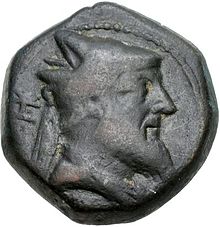Xerxes of Armenia
| Xerxes | |||||
|---|---|---|---|---|---|
| King of Sophene & Commagene | |||||

Coin of king Xerxes, from around 220 BC
|
|||||
| Reign | 228 - 212 BC | ||||
| Coronation | 228 BC | ||||
| Successor | Abdissares, King of Sophene & Commagene | ||||
| Died | 212 BC Sophene |
||||
| Consort | Antiochis | ||||
|
|||||
| Dynasty | Orontid Dynasty | ||||
| Father | Arsames I | ||||
| Full name | |
|---|---|
| Xerxes |
Xerxes (Armenian: Շավարշ – Šavarš, Ancient Greek: Ξέρξης - Xerxes, Old Persian: Ḫšayāršā).
He succeeded his father Arsames I to rule both Sophene and Commagene in 228 BC, his brother Orontes IV ruled Armenia. The satraps of Upper Media Artabazanes, Lower Media Molon and Persis Alexander rebelled against king Antiochus III in 223 BC. Also in 223 BC Achaeus, the Satrap of Asia Minor, rebelled. By 220 BC he put down most of the rebellions, Achaeus was not defeated until 213 BC.
All of these rebellions helps to understand the context, and motives for the subsequent actions of Antiochus III on king Xerxes. By 212 BC Antiochus III had invaded the domain of Xerxes and defeated him after laying siege to the city of Arsamosata. Shortly afterwards Antiochus III arranged for Xerxes to marry his sister, Antiochis. This move seems to show the power or influence Xerxes had in the region. However within the same year she arranged to have her new husband assassinated, thinking that Antiochus III would be able to take control of Sophene. Whether Xerxes had still ruled Commagene by the time of his assassination is not known.
Antiochus III had many military campaigns to take command of and so rather than ruling Sophene he seems to have preferred to place Sophene under the rule of Xerxes son, Abdissares (Zareh).
...
Wikipedia
